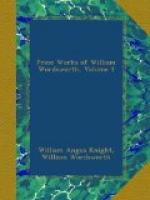After all, the traveller would be most gratified who should approach this beautiful Stream, neither at its source, as is done in the Sonnets, nor from its termination; but from Coniston over Walna Scar; first descending into a little circular valley, a collateral compartment of the long winding vale through which flows the Duddon. This recess, towards the close of September, when the after-grass of the meadow is still of a fresh green, with the leaves of many of the trees faded, but perhaps none fallen, is truly enchanting. At a point elevated enough to show the various objects in the valley, and not so high as to diminish their importance, the stranger will instinctively halt. On the foreground, a little below the most favourable station, a rude foot-bridge is thrown over the bed of the noisy brook foaming by the wayside. Russet and craggy hills, of bold and varied outline, surround the level valley, which is besprinkled with grey rocks plumed with birch trees. A few homesteads are interspersed, in some places peeping out from among the rocks like hermitages, whose site has been chosen for the benefit of sunshine as well as shelter; in other instances, the dwelling-house, barn, and byre compose together a cruciform structure, which, with its embowering trees, and the ivy clothing part of the walls and roof like a fleece, call to mind the remains of an ancient abbey. Time, in most cases, and Nature everywhere, have given a sanctity to the humble works of man that are scattered over this peaceful retirement. Hence a harmony of tone and colour, a consummation and perfection of beauty, which would have been marred had aim or purpose interfered with the course of convenience, utility, or necessity. This unvitiated region stands in no need of the veil of twilight to soften or disguise its features. As it glistens in the morning sunshine, it would fill the spectator’s heart with gladsomeness. Looking from our chosen station, he would feel an impatience to rove among its pathways, to be greeted by the milkmaid, to wander from house to house, exchanging ‘good-morrows’ as he passed the open doors; but, at evening, when the sun is set, and a pearly light gleams from the western quarter of the sky, with an answering light from the smooth surface of the meadows; when the trees are dusky, but each kind still distinguishable; when the cool air has condensed the blue smoke rising from the cottage chimneys; when the dark mossy stones seem to sleep in the bed of the foaming brook; then, he would be unwilling to move forward, not less from a reluctance to relinquish what he beholds, than from an apprehension of disturbing, by his approach, the quietness beneath him. Issuing from the plain of this valley, the brook descends in a rapid torrent passing by the churchyard of Seathwaite. The traveller is thus conducted at once into the midst of the wild and beautiful scenery which gave occasion to the Sonnets from the 14th to the 20th inclusive. From the point where the Seathwaite brook joins the




